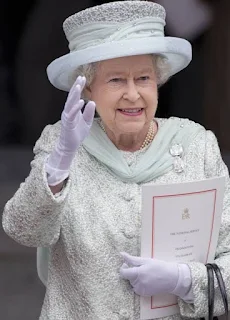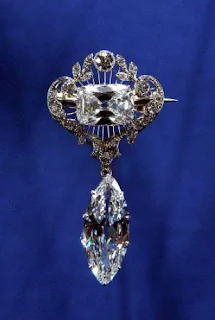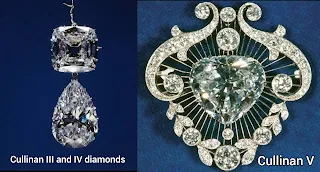The late monarch, Queen Elizabeth II had some of the most extensive collections of diamonds in the world, but her Cullinan Diamonds are the most valuable, cut from the largest diamond ever found in the world.
On May 6, 2023, during the coronation of King Charles III and Queen Camilla, three cuts of the diamonds, the Cullinan III, IV, and V, will take part in the historic event as they will be inserted into Camilla's coronation crown in replacement of the controversial Koh-i-Noor diamond.
 |
| The Queen wore Cullinan III and IV diamond brooches |
 |
| The Queen in 2016 wore the Cullinan V diamond brooch |
 |
| Queen Mary's coronation crown with Ko-i-Noor diamond in the center |
During her long reign, Queen Elizabeth II inherited, received, and commissioned pieces of jewelry expanding her royal jewelry vault into one of the most magnificent royal jewelry collections in the world.
She owned extensive pieces of diamonds, rubies, sapphires, and pearls, however, the Cullinan diamonds are the largest and most valuable in her collection.
Just how these precious diamonds came into the British royal family from South Africa? here's a brief history of Cullinan diamonds.
The history of the Queen's Cullinan diamonds
Named after Thomas Cullinan, the chairman of a South African mining company where the diamond was found, Cullinan diamond still holds the record as the largest diamond ever found in the world. It was found in 1905, weighing 3,106 carats.
The uncut rock was so enormous with such exceptional clarity and a unique blue and white tint that the mine's manager initially dismissed it for a crystal and threw it out the window.
Obviously, a second look would turn out to be highly judicious, though it took some time for the rough stone to be transformed into the nine dazzling diamonds.
 |
| Cullinan VI emerald cut and Cullinan VIII marquise cut |
In 1907, the government of the Transvaal Colony voted to gift the diamond to King Edward VII as a show of good faith and loyalty after the events of the Second Boer War (in which the British empire and two independent Boer Republics, Transvaal among them, fought over imperialism).
Initially, King Edward VII hesitated to accept the diamond, but according to reports, Winston Churchill, then Colonial Under-Secretary, persuaded him to accept it.
The King later commissioned the Asscher brothers, Joseph and Abraham, from the Netherlands to cut the diamonds into several pieces. It took eight months for the Asscher brothers to split and cut the Cullinan diamond.
In 1909, King Edward VII was presented with the two largest gems, the 530.2-carat pear-shaped Cullinan I and the 317.4-carat cushion-cut Cullinan II, which were later incorporated into the Crown Jewels—the Sovereign's Scepter for the former, and the Imperial State Crown for the latter.
He also purchased the 11.5-carat marquise-cut Cullinan VI for his wife Queen Alexandra, then left the rest of the diamond pieces to the Asschers as a form of payment for their work.
But how did the remaining Cullinan Diamonds end up with the British royal family?
The South African government purchased the other pieces of Cullinan diamonds from the Asschers and presented them to Queen Mary, wife of King George V, in 1910. Queen Mary also inherited the Cullinan VI from Queen Alexandra.
The pear-shaped Cullinan III is 94.4-carat and Cullinan IV is a 63.6-carat square-cut piece. They were originally set into Queen Mary's coronation crown (which also held the famous Koh-i-Noor diamond) but she later replaced them with crystal replicas and later wore it as a brooch, which is how Queen Elizabeth wore the jewels during her reign.
 |
| Prince Philip's birthday portrait in 2020, the last time the Queen wore the Cullinan V diamond brooch |
In 1911, Queen Mary commissioned a brooch to anchor the 18.8-carat heart-shaped Cullinan V, which she used in the stomacher of her Delhi Durbar Parure.
Queen Elizabeth II did not wear it as a stomacher instead she wore it as a standalone brooch. And undoubtedly became one of her favorite brooches.
On King Charles III's historic coronation, where his wife will also be crowned along with him, we will be seeing these precious diamonds restyled and part of the coronation crown of the new Queen consort.







0 Comments